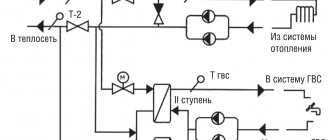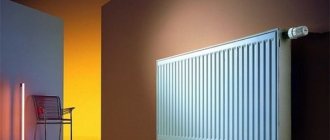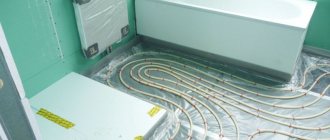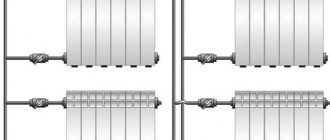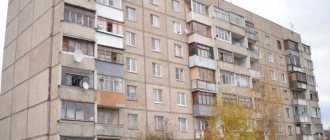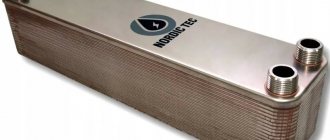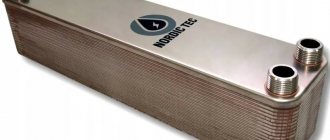A constant supply of hot water to a multi-apartment high-rise building can be carried out using two methods using different operating principles:
- In the first case, the hot water supply of an apartment building takes water from the cold water supply (cold water supply) pipeline, then the water is heated by an autonomous heat generator: an apartment boiler, a gas water heater or boiler, a heat exchanger that uses the heat of a local firehouse or thermal power plant;
- In the second case, the hot water supply scheme of an apartment building takes hot water directly from the heating main, and this principle is used in the residential sector much more often - in 90% of cases of organizing hot water supply in a residential building.
Important: the advantage of the second option of a water supply system for a residential building is better water quality, which is regulated by GOST R 51232-98. Also, when hot water is taken from a centralized heating main, the temperature and pressure of the liquid are quite stable and do not deviate from the specified parameters: the pressure in the pipeline of the hot water supply system is maintained at the level of the cold water supply, and the temperature is stabilized in the common heat generator.
Let us consider the water supply of an apartment building according to the second option in more detail, since this is the scheme that is most often used both in urban areas and in country houses, including country houses or garden houses.
How is it served?
Hot water supply systems are divided into two types: open and closed. When open, the coolant supplied from the centralized heating main to the house is used, then the water is distributed through intra-house networks.
This scheme was developed and implemented during mass construction back in the Soviet period, and has proven its effectiveness and reliability. Most of the multi-storey housing stock is supplied with coolant according to this scheme.
When closed, cold water from the main water supply is used. Water enters an autonomous heating unit, where it is heated to the required temperature, and is pumped into the water distribution network.
Main elements of the thermal unit:
- gas or electric boilers for individual heating;
- instantaneous water heaters;
- heat exchangers using hot water from central main networks.
Advantages:
- The quality of hot water meets the requirements of regulatory documentation for drinking water.
- The consumption of centralized coolant is reduced.
Closed systems are used in modern housing construction. The greatest efficiency of these systems is manifested when using rooftop boiler rooms. In this case, no connection to heating mains is required.
Private sector
What hot water supply schemes with circulation are used in cottages?
Actually, there are only two basic diagrams: with circulation through the water heater (for this it must be equipped with an additional pipe for connecting the DHW return) and with a thermal mixer. The water is driven by a small-sized pump with a wet rotor.
Closed circuit with circulation pump and boiler with three outlets
Pump for heating and hot water needs with a wet rotor
A three-way thermostatic valve allows you to implement recirculation even if in your home an electric boiler or an indirect boiler with two pipes (DHW and make-up) is responsible for heating the water.
Scheme with a conventional boiler and a three-way thermal mixer
Is the water supply located above or below?
The main water pipeline enters the contour of a residential building and ends with a gate valve. In-house networks provide hot water to all consumers.
Through a set of vertical pipelines (risers), the coolant is distributed among the floors. Two types of wiring are used: one-pipe and two-pipe.
The choice of scheme depends on the planning decisions of the residential building:
- The option of supplying water “from below” is used in low-rise buildings. In high-rise buildings with more than nine floors, the coolant is supplied “from above”. In this case, sufficient hot water pressure is ensured on the upper floors.
- In houses with more than eighteen floors, bottling is used “from below”, but the heating system is divided into two autonomous zones. In the upper zone, excess pressure ensures the supply of coolant to the top floors.
- In the old housing stock there are houses that do not have circulation risers - “dead-end systems”. Saving pipes comes at the cost of inconvenience: when the water supply is weak, the water cools down and you have to drain some of the water.
Do housing and communal services have the right to come up with names for their services?
The state seeks to standardize the procedure for paying for housing and communal services, since it is carried out every month throughout the country. Therefore, a list of services has been compiled that have their own names. The organization does not have the right to come up with names, as this may lead to problems for residents of the house with calculations and confirmation of expenses.
The information above indicates that there are several different water supply and heating systems. When developing, the layout, area of the structure, climatic conditions and other points must be taken into account. Therefore, professional companies are involved in drawing up the project. If the proper amount of hot water is not getting into the house or the towel dryer is constantly cold, then there is a possibility that the design developed does not meet the established standards.
Elements in the DHW system
Despite their apparent simplicity, intra-house networks are a rather complex engineering structure. The diameters of the internal distribution pipes, the number and power of booster pumps are calculated in such a way that the water pressure is the same on all floors.
The universal diagram of an open water supply system is as follows:
Water from the heating main passes through a water metering unit, an elevator and enters the heating devices. Additional tie-ins in front of the elevator unit provide hot water supply for hygienic and domestic needs.
System elements also include:
- additional pumps;
- valves,
- valves;
- valves;
- pipelines.
The most complex is the elevator unit.
Node functions:
- adjustment of heating system parameters;
- in severe frosts, when the temperature of the main coolant exceeds 100⁰ C, it provides the ability to switch the hot water supply between supply and return;
- saves main coolant, so the water meter is installed on the return pipeline.
What it is?
It is impossible to organize continuous heating of water using conventional methods, so a simple and effective method is used - the hot water supply line is looped and the circulation process is started.
The flow leaves the boiler, passes in a circle and returns to the heating container.
All that remains is to adjust the speed of movement to ensure the supply of water at the standard temperature for all subscribers of the line.
Circulation pumps are used for movement, although natural circulation is possible in small systems.
DHW distribution in the apartment
In-house wiring serves to deliver hot water to all distribution points. Apartments, as a rule, have one or two hot water connections from common risers.
The valves at these inlets serve as the boundary between areas of responsibility; after the valves, the owner of the apartment is responsible for the operation of the water supply system.
The number of disassembly points varies individually; it is not uncommon to have two toilets, bidets, showers, washing machines and dishwashers. When designing internal wiring, it is necessary to take into account not only the number of disassembly points, but also the individual characteristics of household appliances.
In practice, two wiring methods are used:
- Series or tee circuit: A main pipeline is laid around the perimeter of the apartment, all water consumers are connected to it in series. The diameter of the main pipe must exceed the diameters of the auxiliary pipes.
Tees are used to connect plumbing fixtures and household appliances. This installation is suitable for small apartments. If there are a large number of consumers, the water pipeline becomes too long and the water pressure may not be enough. - Collector circuit. For larger apartments, a collector circuit is applicable. The main difference between this option is the presence of a collector pipe; water flows into it from a common riser.
Plumbing and household appliances are connected to the collector. The volume of the collector must ensure the simultaneous operation of all consumers.
Advantages of the collector circuit:
- the same inlet water pressure is ensured for all consumers;
- the ability to dismantle an individual consumer without disconnecting the entire water supply.
Flaws:
- high cost of installation;
- placement of the collector requires a separate space.
For any apartment wiring scheme, the diameters of the pipelines should not exceed the diameter of the common riser, otherwise the water supply to other apartments will be disrupted.
When is it necessary?
The need for circulation arises in long lines with a large number of subscribers, for example, in apartment buildings or public buildings. In a dead-end pipeline, the water will quickly cool down.
This phenomenon is pronounced at night, when water intake practically stops and the water loses thermal energy.
Starting circulation allows you to:
- constantly update the flow in the pipes,
- heat cooled water to ensure standard values.
In small water supply systems of one-story private houses, circulation is rarely used. The distance from the water heater to the water collection points is relatively small, so it is not advisable to spend money on purchasing or installing a pump, assembling a loop, and starting the process.
It’s easier to let a little water through, which has had time to cool down, to get a normal hot stream.
In two-story houses or cottages, a circulation system becomes a necessity.
Breakdowns and malfunctions
Typical DHW malfunctions include:
equipment failure;- noise in the system operation;
- the temperature of heating devices is below normal;
- weak hot water pressure;
- temperature spread of the coolant across the floors of the house;
- leaks in connections;
- corrosion of pipelines and shut-off valves.
Noises, as a rule, are caused by vibration of incorrectly installed pumps, wear of electric motor bearings, loosening of pipelines, and failure of control valves.
A decrease in the temperature of heating devices is caused by air pockets in the devices themselves, misalignment of the elevator unit, blockages and violation of thermal insulation in heating risers.
Low water pressure in the absence of blockages is most often caused by malfunctions of the booster pumps. Timely maintenance increases the reliability of the heating system.
Payment
Finally, we will answer several questions, one way or another related to the growing tariffs for heat and hot water every year.
How are payments for heating and hot water supply calculated?
The key parameter in charging for heating is the amount of heat spent to maintain a comfortable temperature in the apartment or to heat water. The cost of thermal energy for 2017 is 1000 - 1800 rubles per gigacalorie, depending on the region.
Utility tariffs for 2022 for the city of Berdsk
However, not all apartments have heat meters, so the following appear on receipts much more often:
- Fixed payment for heating a square meter (it is calculated as the product of the heat consumption standard for a given region and the price of a unit of thermal energy);
Simplified diagram: heating costs are calculated based on the square footage of the heated area
- The cost of a cubic meter of hot water, including the meter (90-170 rubles per cubic meter).
How can you save on heating?
To reduce costs you need to:
- Install heat metering devices on each radiator;
- Install chokes or thermal heads on the connections to limit the flow of coolant through the heating device.
The photo shows a sectional radiator with a heat meter and a throttling thermostatic head
Is it possible to use hot water supply to heat an apartment?
Technically yes. To do this, it is enough to form a closed heating circuit (for example, the simplest one-pipe Leningrad) and connect it to the gap in the hot water riser. Since there are no metering devices on the riser, the heat obtained in this way will be absolutely free for you.
The simplest heating system - Leningradka
However:
- Any change in the configuration of public utility networks requires approval from the housing organization and, in the case of hot water supply and heating, from the relevant service providers. It is clear that none of the organizations will give permission for such a change in the heat supply scheme;
- Uncoordinated redevelopment of communications is an administrative offense and is punishable by a fine with an order to restore the original configuration at your own expense;
The Housing Code regards uncoordinated redevelopment of communications as an administrative offense
- Finally, the main thing: you can disconnect from the central heating system only at your entrance or home, providing a plan for an alternative heating scheme and agreeing with electricity or gas suppliers (alternative heat sources). Without an official termination of the heating service, you will continue to receive bills that you want to get rid of.
To stop paying for central heating services, you need to cut off the heating devices from the heating risers and draw up a disconnection certificate with representatives of the housing residents
Temperature requirements
The parameters of hot water in a residential building are regulated by the requirements of GOST 2874-82 and sanitary hygiene standards.
These requirements are provided by resource organizations. The water temperature should be between 60-75⁰ C.
Attempting to use heating water in the water supply network is punishable by law.
Steam production
The huge steam boiler in the turbine hall - the height of a 9-story building is not the limit - can be called the heart of the thermal power plant. It is powered by prepared fuel, releasing a huge amount of energy. Under its force, the water in the boiler turns into steam with an outlet temperature of almost 600 degrees. Under the pressure of this steam, the generator blades rotate, resulting in the creation of electricity.
The thermal power plant also produces thermal energy intended for heating and hot water supply to the region and city. For this purpose, there are selections on the turbine that remove part of the heated steam before it reaches the condenser. The exhausted steam is transferred to a network heater, which acts as a heat exchanger.
Heating network
Once in the tubes of network heaters, the water is heated and transferred through underground pipelines further into the heating network due to pumps driving the water through the pipes. Heating networks, as a rule, carry water at 70-150 degrees - it all depends on the temperature outside: the lower the degree outside, the hotter the coolant.
The central heating point (CHS) becomes the transfer point for the coolant. It serves an entire system of buildings, an enterprise or a microdistrict at once. This is a kind of intermediary between the object that creates heat and the direct consumer. If water in a boiler room is heated due to fuel combustion, then the central heating station works with an already heated coolant.
